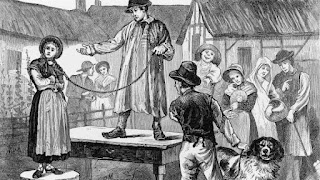English Men Once Sold Their Wives Instead of Getting Divorced
English Men Once Sold Their Wives Instead of Getting Divorced.
Since divorce was expensive during the Victorian era, some men simply opted to sell their wives instead. Much like a cattle auction, the husband would put a rope around his wife's waist, wrist, or neck and take her to the market, where he would sell her off to the highest bidder.
After she was purchased by another man, her previous marriage was considered null and void. And while this wasn't technically legal in England, many authorities looked the other way.
Onlookers shouted as he auctioned her off to the highest bidder, William Harwood. After Harwood turned over a single shilling to Wray, he put his arm around his purchase. “Harwood walked off arm in arm with his smiling bargain,”reported an onlooker, “with as much coolness as if he had purchased a new coat or hat.” It was 1847, and Wray had just gotten the equivalent of a divorce.
The scene sounds like an elaborate joke. In reality, it was anything but. Between the 17th and 19th centuries, divorce was prohibitively expensive.
So some lower-class British people didn’t get them—they sold their wives instead. The custom seems outlandish today, but it could be found in public places like markets, taverns and fairs.
Historians disagree on when or how the custom started and how widespread it was, but it seems to have been an accepted alternative divorce among lower-class Britons. Wife sales were crude and funny, but they also served a very real purpose since it was so hard to get a divorce.
If your marriage broke up in the 1750s, you had to obtain a private Act of Parliament—essentially, an exception to Britain’s draconian divorce law—to formally divorce.
The process was expensive and time-consuming, so wife-selling arose as a form of faux divorce. It wasn’t technically legal, but the way it unfolded in public made it valid in the eyes of many.
People could simply abandon one another, but a woman who entered into relationships with other people were in constant danger of their previous husband swooping in to punish her new lover and get some money in the process.
Legally, her husband could demand that his wife’s lover pay him a large amount of money for having sexual relations with his wife, a right she lacked since courts didn’t allow wives to sue their husbands for adultery. Wife sales were a way to sidestep that risk.
Oddly enough, the sales took on the form of cattle auctions of the time. After announcing the sale, the man would put a ribbon or a rope around his wife’s neck, arm or waist and lead her to “market” (either an actual market or another public place).
Then, he’d auction her off, often after declaring her virtues to the onlookers. Once she was purchased by another man, the previous marriage was considered null and void and the new buyer was financially responsible for his new wife.
Usually, wife sales were merely symbolic—there was just one bidder, the woman’s new lover. Sometimes there wasn’t a designated buyer, though, and an actual bidding war broke out.
Men could announce a wife sale without informing their wife, and she might be bid on by total strangers. But women had to agree to the sale.
It would seem that the woman was at a disadvantage during a wife sale, but that wasn’t always the case. Since she was still married to her first husband under the law, he was technically entitled to all of her possessions (at the time, married women’s property all belonged to their husbands).
The public nature of the sale, though, made it clear to one and all that the seller gave up his right to his former wife’s possessions.
And the woman also sidestepped the very real threat of having her new lover sued by her first husband for “criminal conversation.”


.jpg)

.jpeg)






Comments
Post a Comment